Stay Away From Throttle Body Spacers
The engine in your Tundra is essentially a giant air pump – the more air that you can get into your motor, the more fuel that can be mixed with it and then combusted in order to generate more horsepower. There are a lot of different methods out there designed to help an engine “breathe” and maximize its power potential. Truck owners install performance air filters, cold air intakes, and even superchargers in order to get the most airflow possible, all in a chase for that extra horsepower edge.
There are some products out there that claim to be able to improve on the already significant engineering that has gone into your motor. Some of these products, like performance air filters and cold air intakes, work as advertised. These accessories improve performance because they trade an increase in performance for an increase in something else. In the case of air flow, it’s usually a trade between increased engine noise and an increase in power (not to mention expense).
Unfortunately, these usually simple enhancements sometimes claim excessive increases in horsepower and fuel mileage. We’ve tested a few cold air intakes and none of them matched the results printed on the box. Having said that, none of them disappointed us. However, one device that we have a hard time endorsing is known as a throttle body spacer.
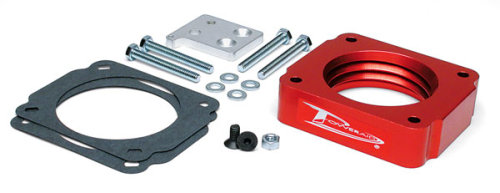
We don’t recommend AirRaid’s throttle body spacer, or any other brand of throttle body spacer, for the Toyota Tundra (or any other modern fuel injected vehicle). Read more…
K and N Air Filter Review: Save $1100 On Gas!
We’ve spent a lot of time reviewing cold air intakes here on TundraHeadquarters.com, and for good reason. Cold air intakes offer increased performance, improved gas mileage, go-fast looks, and a great sound. These kits work because they increase air flow into the engine while also making an effort to ensure the intake air is as cool as possible. Unfortunately, while they do work, cold air intake kits cost $300-$400.
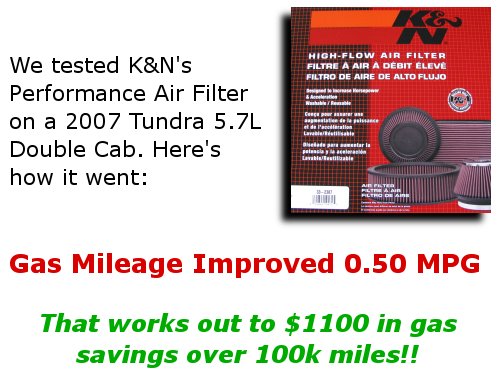
For years, K&N has been offering a less expensive alternative to cold air intake kits, specifically, a high-performance air filter. K&N says that their high-flow air filters significantly increase air flow and therefore offer many of the same benefits as more expensive full-fledged intake kits. We decided to check that claim, and here’s what we came up with: Read more…
After Market Toyota Tundra Exhaust Systems
No doubt you’ve been out driving your Tundra and had your head turned by the rumbling exhaust of another full size pickup driving by. There’s just something about the deep, throaty sound of a V8 engine amplified by a set of wide pipes and performance mufflers. Fortunately, there are dozens of options for getting that same aggressive sound on your Tundra – not to mention some nice horsepower gains. Let’s take a look at some of the options out there.
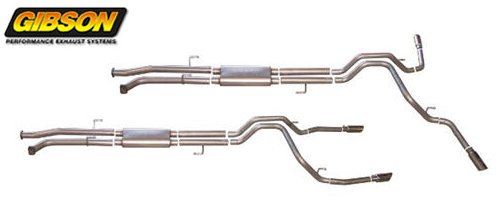
Gibson Exhaust offers aluminized and stainless steel cat-back exhaust systems with single pipes – either rear or side exit – as well as dual pipes with rear or side exits. Pricing starts at about $450 including shipping. Read more…
Toyota Consolidates Tundra Manufacturing, HD Tundra Tabled?
In a very wise move, Toyota has announced that they’re going to consolidate all Tundra production to the San Antonio plant. Currently, Tundras are produced in both San Antonio, Texas and Princeton, Indiana. Originally, before the launch of the 2nd-generation Tundra, Toyota decided to produce the Tundra at a couple of different plants for a few reasons:
- Facilities and convenience. The Princeton plant was the home of the original first-gen Tundra, and a lot of suppliers for the 2nd-gen truck were nearby and accustomed to working with the Princeton, Indiana plant.
- Quality at launch. Toyota wisely determined that launching an all-new truck at an all-new plant might be a quality control issue, so they decided to use the tried-and-true Princeton plant to produce the new truck along with the new San Antonio plant. This reduced the number of variables when it came to quality control and helped Toyota isolate production problems correctly.
- Capacity. This is the main reason – Toyota anticipated they would need all the production capacity they could get for the new Tundra half-ton and upcoming Tundra HD. At full speed, the Princeton plant could build 150k new trucks per year. The San Antonio plant has the capacity to build 250,000 units per year. Obviously, Toyota anticipated producing as many as 400k units between the two plants. Considering the future plans that were being discussed at the time – a diesel HD version of the Tundra as early as 2009, for example – it was determined this capacity was needed.
What this means to you: If you’re waiting for an HD Tundra, you might be waiting a while. The costs of producing a diesel HD Tundra are substantial. Not only are there quite a few R&D costs (such as designing a new big diesel, platform design, etc.), but now there are production concerns too. Since the San Antonio plant has a maximum annual production capacity of 250k units, there’s not a lot of extra capacity to build an HD version of the Tundra.
Here’s why: Read more…
Hypertech’s Speedometer Calibration Module
The Tundra’s ECU, or engine control module, administrates most aspects of your truck. Transmission shift points, air/fuel mixture, engine timing, and other performance settings are controlled by the ECU, as well as more mundane settings like overall tire size. In the world of after market parts, selling programmers that can change these ECU settings has become a big business. Factory engine calibrations usually emphasize things like emissions and fuel economy – change these factory settings (even slighty) and you can often add significant power.
Unfortunately for us, Toyota isn’t a fan of after market engine programmers. Toyota designed their ECU in a way that makes changing factory computer calibrations nearly impossible, even when it comes to changing the most basic of settings. Fortunately, when it comes to oversized wheel/tire packages or gear changes, Hypertech has come up with an in-line Speedometer Calibrator Module that allows you to compensate for your wheels and tires without having to re-program the ECU.
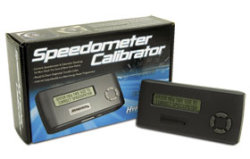
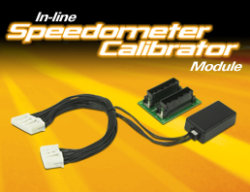
NOTE: To date, Hypertech is one of the only aftermarket tuner/programmer companies with Toyota Tundra applications. And, although the speedometer calibrator does just one of the many jobs we expect from this upgrade, the engineers at Hypertech are working on creating a programmer for the Tundra. Read more…

